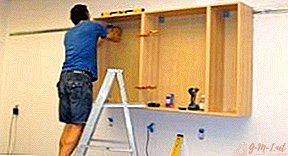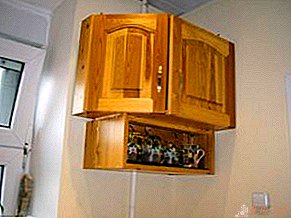 Today, drywall is widely used for finishing cladding. This popularity is due to the fact that a set of plasterboard sheets and steel profiles makes it possible to quickly smooth out any wall surface, eliminate defects, and realize all the ideas of designers. Despite its merits, the material is quite fragile, so doubts often arise whether it is possible to hang cabinets on plasterboard walls.
Today, drywall is widely used for finishing cladding. This popularity is due to the fact that a set of plasterboard sheets and steel profiles makes it possible to quickly smooth out any wall surface, eliminate defects, and realize all the ideas of designers. Despite its merits, the material is quite fragile, so doubts often arise whether it is possible to hang cabinets on plasterboard walls.
Important rules for attaching the cabinet to drywall
Basic rules for the performance of work:
- Carefully select the material. Choose dowels, anchors and other fasteners of only high quality.
- Before carrying out the work, carefully take measurements, this will avoid a lot of errors and do not have to redo the work.
- Use protective equipment during operation: glasses, gloves, etc. This will prevent possible personal injury.

Methods for attaching the cabinet to a drywall
To begin with, determine the mass of the cabinet. Given this factor, several types of fasteners and various techniques are used, which make it possible to firmly fix the furniture on drywall.
Using a mortgage beam
The embedded parts are pre-mounted in a drywall at the required distance during the assembly of the frame.
The main advantage of the method is the ability to firmly fix the cabinet on any part of the mortgage. A mortgage is a frame jumper consisting of pieces of a profile with installed bars:
- First, a dry beam of the required size is selected. In order to adjust the furniture in height and when fastening it is not to be greased with a self-tapping screw past the mortgage, the beam width must be at least 10 cm.
- The beam must be sawn into the required number of segments of the desired size.
- Each segment is installed between the profile, and is attached horizontally to the wall in 2-3 places.
- The height of the timber fastening is chosen so that the axis is at the level of the furniture fastening points.
- After fixing the mortgages, you need to measure the area on the wall where they are located and record the dimensions of their location, after which you can proceed to plasterboard casing.
- When it will be necessary to fix the cabinets, a horizontal line must be drawn on the wall at the required distance from the floor level.
- Then you need to raise each product to a predetermined height and attach it through the hinges using self-tapping screws.

Horizontal tire
In the set of wall cabinets there are usually special tires - a rigid bar with bends for fixing furniture to hooks.
The tire is fixed to the wall where it is necessary to hang the cabinet. That is, the main emphasis is on the reliability of the fasteners of this particular element, since the furniture will hang on the tire without contact with the wall.
Mounting is performed as follows:
- The tire is fixed with self-tapping screws to the carcass profiles through drywall.
- In areas where there is no profile, dowels are used.
Attention! You can find the profile under the drywall sheathing using a magnet.
Dowels
A screw-in dowel can withstand up to 30 kg of weight. Accordingly, two mounts can withstand 60 kg. So this kind of mount can be used in the kitchen.
The dowel is screwed into the drywall with a screwdriver. Plastic fasteners may break when screwed in. To prevent this, builders advise to make a hole with a diameter of 5-6 mm at the site of screwing in with an electric drill, and then install a dowel. Furniture is attached to a plastic dowel with a self-tapping screw.
Expandable Anchor Fasteners
The expandable mount is harder to use, but much more reliable. During tightening, the part of the anchor, which is located behind the drywall, is compressed and diverges on the sides.
This approach makes it possible to fix not only cabinets, but also chandeliers - one anchor can hold a load of up to 50 kg.
Typically 2 types are used:
- "Molly". Anchor with steel dowel and screw.
- "Butterfly". Anchor with a plastic core and a screw.
To fasten furniture at marked points, a hole is made with a drill for the corresponding anchor diameter. After the fasteners are installed in the loose state, the edge on the end will not allow the fasteners to fall into the wall.
Then, a screw is screwed into the dowel through the hinges of the cabinet. Significant efforts during tightening do not need to be applied - with a constriction, the screw can turn, and the fastening must be changed.
How to choose the right hardware
Plasterboard sheets with a thickness of not more than 12 mm are usually used for wall cladding. This material is quite durable and has high resistance to stress. But the fastening of a heavy wall cabinet, the mass of which after filling with various objects can be more than 70 kg, is fraught with the fact that the fastening will break out of the plaster. Therefore, you need to calculate the weight of the furniture and make the right choice of the appropriate fasteners.
The main advantage of hanging on fasteners without mortgages is that this option can be used on an already lined drywall wall. That is, if the plans do not intend to overhaul the room in the near future and do not want to disassemble the finished wall - this is the best way.
Among the drawbacks of this solution, it should be noted that fasteners that can withstand a large load can be found on sale very rarely and their cost is quite high. And, of course, you need to know which mount can be used in a particular case, and which not.
Attention! Installing mortgages under drywall is the best solution if you need to hang heavy furniture, for example, kitchen cabinets weighing more than 40 kg. In fact, the fasteners in this case are not made on gypsum plasterboard, but on wooden mortgages that are rigidly fixed to the supporting wall.
The disadvantages of this solution include the inability to use on already prepared and operated wall surfaces. That is, mortgages must be mounted for decoration, and this can only be done before plasterboard sheathing.
The combined method can be used in cases where the width of the embedded elements under the cladding partially does not coincide with the location of the loops that are attached to the mounted product.
Fastening to a drywall wall can be done by yourself. This process does not require special knowledge, the most important thing is to strictly follow the instructions. Despite all the advantages, drywall is still a relatively new building material. Its properties are not fully tested, therefore it is advisable to consult with specialists. Do not forget that drywall is afraid of high humidity. Do not use it in bathrooms. The material will swell over time, become more plastic and softer.




Leave Your Comment